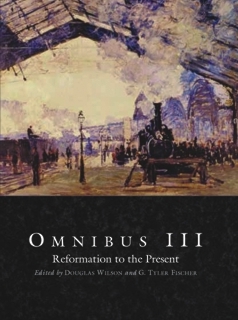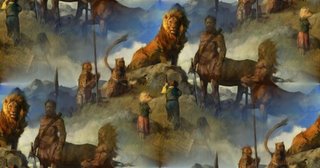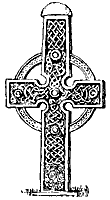I'm going to start posting some material from the
Logres Hall website, for those who may only be readers of this blog. Here's the first such post, one on the ever-popular
Veggie Tales.
The heart of Logres Hall is the desire to build a culture of storytelling in the Christian family. Built on the foundation of the Bible, this culture would be a like a small cathedral - carefully crafted to embody goodness, truth, and beauty in its very architecture. I have posted some original short stories and poetry (some attempts at bringing the storytelling culture to life), but I also want to offer some thoughts and observations on the work of building. Besides the goodness, truth, and beauty, the purpose of such a culture is to build character in the lives of our children. There is no better way to do it. But we want to think biblically about the various attempts at storytelling around us, and the article below is one attempt at doing just that. The idea is to provide reviews of children's books and films (contemporary as well as older works) and articles on the art of storytelling. These are merely conversational catalysts, not authoratative pronouncements, and I welcome any comments.
Veggie Fables'We pursue great art because we are convinced that great art - combined with great storytelling - can change the world.' Phil Vischer, founder of Big Idea Productions
Few Christian success stories can rival that of the meteoric rise of
Big Idea Productions, and their centerpiece work,
Veggie Tales. Starting small, they still managed to beat everyone else, including Disney and Pixar, in releasing the first fully computer-animated video (
Where's God When I'm S-Scared) in history. Millions of videos, t-shirts, lunchboxes, coloring books, and dollars later, they are at the top of the children's entertainment world, both Christian and secular. Even recent news that the company has filed for bankruptcy has not diminished the wild popularity of
Veggie Tales.
Obviously, all successes have their detractors, and
Veggie Tales are no exception.
Nathan Wilson, whose well-known pop Douglas Wilson founded the edgy Reformed journal
Credenda Agenda, found no kind words to say about the biggest
Veggie project to date:
Jonah: A Veggie Tales Movie, calling it 'The only movie more pagan than
The Matrix: Reloaded that I have seen recently.' Wilson explains: 'Where
Matrix merely blasphemes through false and twisted allusion,
Jonah claims friendship to the faith, and then spits on the Ark of the Covenant for laughs.' Since some may not have got the point, he adds this for emphasis: 'While I'm sure they're out there, I can't think of a movie more disrespectful toward Scripture since
Life of Brian from Monty Python.'
Jonah, he writes, is little more than 'smiling evangelical goop.'
Other writers have leveled criticism, without as much fist-shaking as Wilson.
Gary DeMar, perhaps best known for critiquing the theology of Tim LaHaye's
Left Behind, wrote an article for his own magazine,
Biblical Worldview, in which he suggests that, while the
Veggie videos are clever and well-produced, they ought to lay off the Bible stories. The
Veggie Tales Biblical adaptations, he says, 'present the Bible as a compilation of morality tales and obscure its redemptive message by presenting morality as the Bible's end-message.'
If you want to enjoy
Veggie Tales,' DeMar adds, 'stick to Silly Songs and moral lessons, and leave the telling of Bible stories to someone else.'
I don't wish to challenge either Wilson or DeMar, for I think they both make good points, if somewhat open to challenge here and there. Rather, I want to suggest a paradigm for defining
Veggie Tales at its best, and what I am proposing is that the
Veggie Tales stories represent a contemporary, albeit pop culture version, of the classic beast fable.
If it needs to be said, let me say it: of course they are vegetables, not beasts, but I am arguing that Bob the Tomato and Larry the Cucumber function in much the same way as Brer Rabbit, the Three Little Pigs, Rat, Mole, Toad, and Badger from
The Wind in the Willows, or Chanticleer the Rooster from Chaucer's
The Nun's Priest's Tale. And whether they are as good as those classic stories is not the point.
Britannica defines a beast fable as 'a prose or verse fable or short story that usually has a moral.' I could almost stop here, letting the definition alone make the point. Usually prose, sometimes in verse ('Silly Songs with Larry' comes to mind),
Veggie Tales certainly qualify as short stories with morals. In many ways, that is the whole point of their existence.
Indeed, a friend of mine has wondered whether they don't lapse into mere moralism at times. But while thinking Christians rightly reject moralism (the reduction of the Christian faith to mere ethical norms), we heartily embrace morality, and the idea of objective good and evil. Unless we are looking to
Veggie Tales for theological guidance (and of course we should not), we ought not accuse them of moralism when they are merely performing the function of classic morality tales, such as the beast fables.
But the beast fable is not merely a morality tale, and theological truth need not be absent - would anyone suggest that there is no theology in
The Wind in the Willows? And of course it's true that if
Veggie Tales serves up theology through trivialized retellings of Bible stories, then they likely will end up with the narratives of Scripture coming off as just so many Chinese proverbs. But theological truth can become incarnate in a story, and the
Veggie Tales characters occasionally manifest such truth, as we will see.
Britannica adds this to its definition: 'In beast fables animal characters are represented as acting with human feelings and motives.' Tolkien, in his famous essay 'On Fairy Stories,' goes farther, noting that beast fables are 'stories in which no human being is concerned; or in which the animals are the heroes and heroines, and men and women, if they appear, are mere adjuncts; and above all those in which the animal form is only a mask upon a human face, a device of the satirist or the preacher....'
Of course the good satirist or preacher wants to delight and entertain as well. And this is precisely what
Veggie Tales videos do: entertain while satirizing and teaching. Again, we might debate how well they do this, and I am not suggesting that the
Veggie videos are on the same artistic level as Aesop or Chaucer, but I am saying that, as stories, they belong in the same category. If this is the case, then it is wrong to attack them for a lack of theology, for this is not their function, and in fact would probably be out of place.
Though, for the record, it is not impossible to find theological statements in
Veggie Tales. One example comes from the video
The Star of Christmas, in my opinion the best
Veggie production so far. After Bob and Larry wreak havoc trying to produce a play that will teach Victorian-era London 'how to love,' an imprisoned thief gives his opinion of the matter: 'if you ask me, you can't teach a man how to love. It's not in his nature.' Simple, yes, and not particularly profound, but it is a theological statement (file under 'H' for "Hamartiology") and it is accurate, as far as it goes. Further, it is far better than the syrupy 'everyone is basically good' drivel that one finds in so many other Christmas programs for children.
Another example is in the recent
Sumo of the Opera, in which a new segment, 'Lutfi's Fanciful Flannelgraph,' in the course of telling the story of St Patrick, actually teaches children the doctrine of the Trinity in perfectly orthodox language ('He is God the Father, God the Son, and God the Holy Spirit. One God, Three Persons.').
But again, doctrinal instruction is not the function of a beast fable. Entertainment via satire and moral highlighting is. And few would deny that
Veggie Tales do both.
Consider a few examples: the
Veggie story
Madame Blueberry hilariously lampoons both greed and consumerism, making moderation and contentment look attractive in the process.
Lyle, the Kindly Viking thrusts a spear through theft, the worship of power, even piracy (sort of), while highlighting the virtues of love, courage, and mercy. And the various
Larry Boy stories have taken on such evils as gossip and lying while lifting the standard of truth-speaking for all Bumblyburg to see.
Notice that in each example, a moral dialectic is employed, portraying an antithesis between good and evil. Not content merely to scold, these fables present the alternative virtues as not only right, but good and lovely. And - I must add - it's hard not to love anyone who takes such a great shot at the perverted joke Disney has become: in the aforementioned
Sumo, again during the story of St Patrick, the Druids are described as those who 'did not know about God. They practiced a religion known as 'Paganism...instead of praying to God, Pagans prayed to things like twigs ("Oh, mighty Twig, you are powerful and twig-like") and pond scum ("Oh mighty Pond Scum, you are powerful and, uh, scummy")
and they painted with all the colors of the wind." (Emphasis added. If you don't get it, watch Disney's
Pocohantas - but not with your kids.)
Veggie Tales are certainly open to legitimate criticism, largely for their oft-hapless attempts at adapting Bible stories (the narrative of David's lust for Bathsheba, for example, is recast as King George's lust for rubber duckies), as DeMar points out so well. And certainly, kids can live and grow up without them.
Beowulf, Sir Gawaine and the Green Knight, Aesop, The Hobbit, The Chronicles of Narnia, The Princess and the Goblin- these are indispensable in our children's cultural lives, unlike Veggie Tales and other pop fare. But if we recognize them as pop-culture variations of the beast fable, and if our children's literary canon extends beyond, say,
Left Behind: the Kids, then I daresay an occasional serving of raw cucumbers and tomatoes won't hurt them.
So if Mom and Dad enjoy the sophisticated humor and eye-catching animation of
Veggie Tales, but feel guilty about it, perhaps an understanding of the literary place of the
Veggie stories - as contemporary beast fables - will encourage them not to write these videos off as mere kiddie fare, nor to expect them to be the Saturday morning equivalent of the
Shorter Catechism.
But maybe Mom and Dad should be the ones to teach the children about Jonah.


















 First, thanks again to John for taking time to engage in this conversation. Here are some additional thoughts inspired by John’s answers. I have told John I would print anything he might like to say in response to these thoughts. John’s words are in bold print, and my answers are in normal type.
First, thanks again to John for taking time to engage in this conversation. Here are some additional thoughts inspired by John’s answers. I have told John I would print anything he might like to say in response to these thoughts. John’s words are in bold print, and my answers are in normal type.